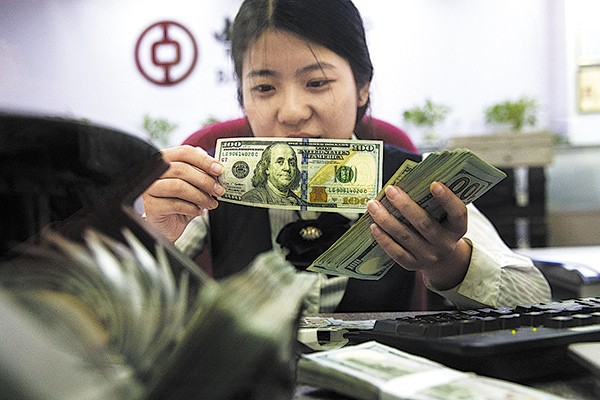
A clerk checks dollar bills at a bank outlet in Taiyuan, capital of Shanxi province.[Photo/China News Services]
China’s monetary authority listed steady progress to achieve completely free use of the yuan in cross-border capital investment as one of its priorities this year, based on further market-oriented exchange rate reform, said a statement released on the central bank’s website on May 8.
Pan Gongsheng, vice-governor of the People’s Bank of China and director of the State Administration of Foreign Exchange, called for expansion of the global use of the yuan under a “macro prudential” management framework to monitor market fluctuations.
These points, part of the central bank’s 2018 annual work plan, were released after the nation’s policymakers introduced reforms to further open the domestic financial sector to foreign investors.
The renewed strength of the US dollar in the past two weeks, when the dollar index that measures the greenback against a basket of peers rose by nearly 2.5 percent to a new peak of 93.0516 on May 8, the highest since December, has added depreciation pressure on the Chinese currency.
The yuan’s daily trading reference, its central parity, dropped by 1 percent over the same period, and the depreciation of the currency in the offshore market was even greater, at a rate of about 1.2 percent. The yuan’s central parity was 6.3674 per dollar on Tuesday.
“There will be concerns that the extended run of dollar-buying momentum risks spelling pain for emerging markets in ways not seen since the US Federal Reserve began raising its interest rates back in 2015,” said Jameel Ahmad, global head of Currency Strategy and Market Research at ForexTime.
Experts said that rising inflation and the expected US Fed rate hike in June would continually strengthen the US dollar, which has been catalyzed by the growth of 10-year US treasury yields to above 3 percent — the first time since 2014. They speculated that increased interest rate differentials between the US and other major economies were behind the recent fluctuations in the US dollar.
Cross-border capital flows should be watched closely in the coming months, but the influence on China is limited due to its experienced cross-border capital flow risk management, according to Jing Ulrich, managing director and vice-chairwoman of JP Morgan, Asia-Pacific.
With a wider opening of China’s financial sector, the currency’s exchange rate will get closer to the market’s equilibrium level, and possibly reach 6.25 per US dollar by the end of this year, with more balanced two-way capital flows, according to Ulrich.
“The government’s encouragement of the global use of the yuan is expected to boost Chinese corporates and financial institutions to develop overseas businesses, which will lead to a rise in the yuan’s market share,” she said.
According to a recent assessment by China’s central bank, the yuan ranked sixth globally as an international payment currency by 2017, and more than a quarter of cross-border trade was settled in yuan. More than 60 foreign countries have adopted the yuan as their reserve currency.
